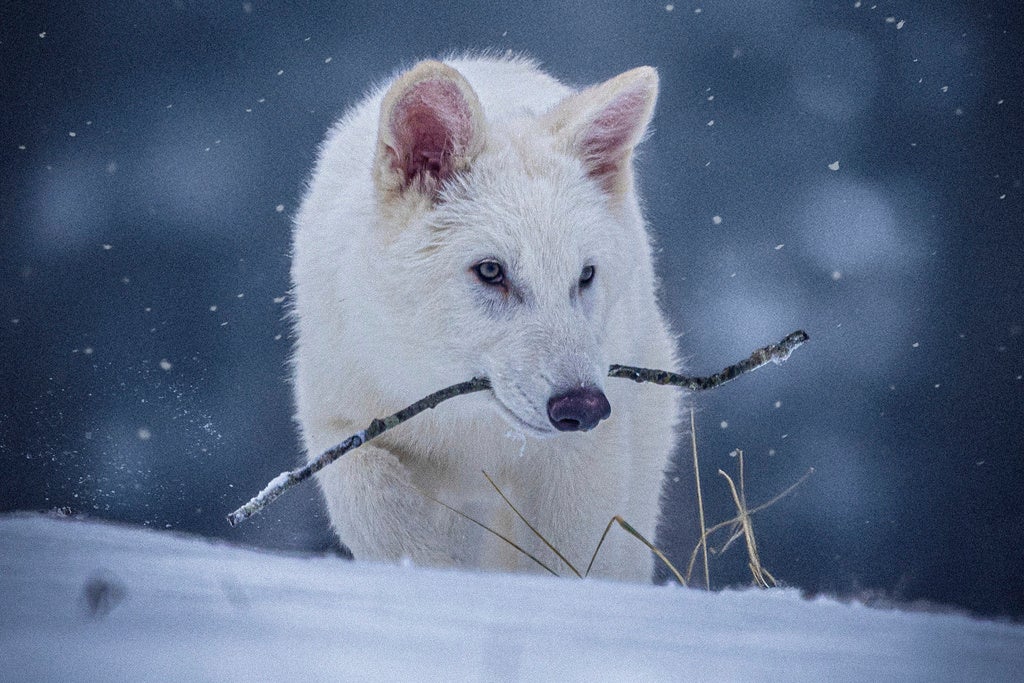<div class="js-react-hydrator" data-component-name="YouTube" data-component-id="8759" data-component-props="{"itemType":"video","index":0,"contentIndexByType":1,"contentListType":"embed","code":"
","type":"video","meta":{"author":"ABC News","author_url":"https://www.youtube.com/channel/UCBi2mrWuNuyYy4gbM6fU18Q","cache_age":86400,"description":"ABC News was given exclusive access to the Dallas laboratory where Colossal Biosciences says it brought the dire wolf back to life – a species that’s been extinct for 13,000 years.\n\n–––\n\nSubscribe to ABC News on YouTube: https://abcnews.visitlink.me/59aJ1G\n\nABC News is your daily source of breaking national and world news, exclusive interviews and 24/7 live streaming coverage.\n\nDownload the ABC News app for the latest headlines and alerts: https://abcnews.go.com/devices\n\nWatch 24/7 coverage of breaking news and live events on ABC News Live: https://www.youtube.com/watch?v=gN0PZCe-kwQ&ab_channel=ABCNews \n\nWatch full episodes of World News Tonight with David Muir here: https://youtube.com/playlist?list=PLQOa26lW-uI8ixlVw1NWu_l4Eh8iZW_qN&feature=shared \n\nRead ABC News reports online: http://abcnews.go.com\n\nABC News is the home to the #1 evening newscast “World News Tonight with David Muir,\" “Good Morning America,” “20/20,” “Nightline,” “This Week” with George Stephanopoulos, “ABC News Live Prime” with Linsey Davis, plus the daily news podcast “Start Here.”\n\nConnect with ABC News on social media: \nFacebook: https://www.facebook.com/ABCNews \nInstagram: https://www.instagram.com/abcnews \nTikTok: https://www.tiktok.com/@abcnews \nX: https://twitter.com/ABC \nThreads: https://www.threads.net/@abcnews \nWhatsApp: https://whatsapp.com/channel/0029VajTNakKWEKkXoAPIR11\nLinkedIn: https://www.linkedin.com/company/abcnews","options":{"_cc_load_policy":{"label":"Closed captions","value":false},"_end":{"label":"End on","placeholder":"ex.: 11, 1m10s","value":""},"_start":{"label":"Start from","placeholder":"ex.: 11, 1m10s","value":""}},"provider_name":"YouTube","thumbnail_height":720,"thumbnail_url":"https://i.ytimg.com/vi/uxo2xIBe_0Y/maxresdefault.jpg","thumbnail_width":1280,"title":"Scientists: Dire wolf brought back from extinction after 13,000 years","type":"video","url":"https://www.youtube.com/watch?v=uxo2xIBe_0Y","version":"1.0"},"flags":[],"enhancements":{},"fullBleed":false,"options":{"theme":"news","device":"desktop","editionInfo":{"id":"us","name":"U.S.","link":"https://www.huffpost.com","locale":"en_US"},"originalEdition":"us","isMapi":false,"isAmp":false,"isAdsFree":false,"isVideoEntry":false,"isEntry":true,"isMt":false,"entryId":"67f53d76e4b0d8a978d99111","entryPermalink":"https://www.huffpost.com/entry/wolves-genetically-engineered-dire-wolf_n_67f53d76e4b0d8a978d99111","entryTagsList":"crispr,associated-press-health-science-department,matt-james,colossal-biosciences,beth-shapiro,colossal,christopher-preston,ben-lamm,southeastern-us,@ai_seo_headline,@ap_wire_import,@nosyndication,@us_huffpost_now,@wire","sectionSlug":"science","deptSlug":"impact","sectionRedirectUrl":null,"subcategories":"world-news,weird-news,green,technology","isWide":false,"headerOverride":null,"noVideoAds":false,"disableFloat":false,"isNative":false,"commercialVideo":{"provider":"custom","site_and_category":"us.science","package":null},"isHighline":false,"vidibleConfigValues":{"cid":"60afc111dcf87c2cd2f5d8bf","overrides":{"front_page_top_videos":{"desktop":"60b64354b171b7444beaff4d","mobileweb":"60b64354b171b7444beaff4d"},"top_media":{"desktop":"60b8e6bdc5449357a7ada147","mobile":"60b8e701c5449357a7ada2ee","iphone":"60b8e643cdd90620331bb1f6","ipad":"60b8e643cdd90620331bb1f6","androidphone":"60b8e699c5449357a7ada04c","androidtablet":"60b8e699c5449357a7ada04c"},"anthology":{"desktop":"60b8e616cdd90620331bb0ba","mobile":"60b8e671c5449357a7ad9f66","iphone":"60b8e643cdd90620331bb1f6","ipad":"60b8e643cdd90620331bb1f6","androidphone":"60b8e699c5449357a7ada04c","androidtablet":"60b8e699c5449357a7ada04c"},"content":{"desktop":"60b8e616cdd90620331bb0ba","mobile":"60b8e671c5449357a7ad9f66","iphone":"60b8e643cdd90620331bb1f6","ipad":"60b8e643cdd90620331bb1f6","androidphone":"60b8e699c5449357a7ada04c","androidtablet":"60b8e699c5449357a7ada04c"}},"playerUpdates":{"5668ae6ee4b0b5e26955d6a6":"60d2472d9340d7032ad7e443","56aa41bae4b091744c0440d8":"60e869dc7c5f3b17b6741b81","5841b2b5cc52c716ec6e5a7f":"60b8e355cdd90620331ba185","58b5e2b8d85a10302feee895":"60b64316b171b7444beafdb2","58b74698f78ced31417819ae":"60b8e5bec5449357a7ad9b52","58b74ccecebcea57e2c3a3d1":"60b8e5eac5449357a7ad9ca5","58cff690d85a100b9992bc39":"60b8e616cdd90620331bb0ba","58cffb3fb6d9b972a49a3c9d":"60b8e643cdd90620331bb1f6","58cffdd74d96935d7d6ec180":"60b8e671c5449357a7ad9f66","58d03a84f78ced6518eb2fa7":"60b643c82e76be41f112735c","592edf20e0fa177b0c26f7fd":"60b8e699c5449357a7ada04c","5b35266b158f855373e28256":"60b64354b171b7444beaff4d","5c116f29f79c4171d82b7c2a":"60b64440b171b7444beb040b","5c1170fc600c9a697bf0c6b9":"60b646102e76be41f1127ffc","5c47791afa1b317df8ae0c4f":"60b8e6bdc5449357a7ada147","5c477987a6b48b35f164773d":"60b8e701c5449357a7ada2ee","5c4779ee943c3c2a64f28371":"60b8e747cdd90620331bb861","5c477a26fcd67b26879bc7c2":"60b8e788c5449357a7ada67b","5d8921a78c3ae845f366c9b6":"60ae7be5f3a7c13a30417ff9","58b98b00ba82aa39a6534321":"60d0de7c9340d7032ad1146c","58b9d14cb6d9b96c9ec32af3":"60d0dec19340d7032ad115a0","58cff8eccebcea42931e0436":"60d0e005b627221e9d819d44","592edf5de0fa177b0c26f95b":"60d0e38fb627221e9d81adcf","58cff72fd85a100b9992c112":"60d0e447b627221e9d81b0da","56b4d34fe4b022697697c400":"60d2472d9340d7032ad7e443","60b8e4c0c5449357a7ad957d":"60e869dc7c5f3b17b6741b81"}},"connatixConfigValues":{"defaultPlayer":"ff7fdddc-5441-4253-abc4-f12a33fad58b","clickToPlayPlayer":"d014396e-b366-4c17-aeac-3ce906fa3fd0","videoPagePlayer":"f010447b-d244-4111-a314-7b4542ae4145","verticalPlayer":"e58cb05a-0bc8-4210-9108-fea82726c065","stickyPlayerControl":"52ea1755-d601-4ad1-bccc-d8cce3f0e5da","stickyPlayer":"8055e9e5-3bda-4933-8d45-9ad814fb6e22","noAdsPlayer":"deeeda04-49cb-4a1d-ac6c-c388a685b58e"},"topConnatixThumnbailSrc":"data:image/png;base64,iVBORw0KGgoAAAANSUhEUgAAAAEAAAABCAQAAAC1HAwCAAAAC0lEQVR42mNkYAAAAAYAAjCB0C8AAAAASUVORK5CYII=","customAmpComponents":[],"ampAssetsUrl":"https://amp.assets.huffpost.com","videoTraits":null,"positionInUnitCounts":{"buzz_head":{"count":0},"buzz_body":{"count":0},"buzz_bottom":{"count":0}},"positionInSubUnitCounts":{"article_body":{"count":3},"blog_summary":{"count":0},"before_you_go_content":{"count":0}},"connatixCountsHelper":{"count":0},"buzzfeedTracking":{"context_page_id":"67f53d76e4b0d8a978d99111","context_page_type":"buzz","destination":"huffpost","mode":"desktop","page_edition":"en-us"},"tags":[{"name":"crispr","slug":"crispr","links":{"relativeLink":"topic/crispr","permalink":"https://www.huffpost.com/topic/crispr","mobileWebLink":"https://www.huffpost.com/topic/crispr"},"url":"https://www.huffpost.com/topic/crispr"},{"name":"Associated Press Health Science Department","slug":"associated-press-health-science-department","links":{"relativeLink":"topic/associated-press-health-science-department","permalink":"https://www.huffpost.com/topic/associated-press-health-science-department","mobileWebLink":"https://www.huffpost.com/topic/associated-press-health-science-department"},"url":"https://www.huffpost.com/topic/associated-press-health-science-department"},{"name":"Matt James","slug":"matt-james","links":{"relativeLink":"topic/matt-james","permalink":"https://www.huffpost.com/topic/matt-james","mobileWebLink":"https://www.huffpost.com/topic/matt-james"},"url":"https://www.huffpost.com/topic/matt-james"},{"name":"Colossal Biosciences","slug":"colossal-biosciences","links":{"relativeLink":"topic/colossal-biosciences","permalink":"https://www.huffpost.com/topic/colossal-biosciences","mobileWebLink":"https://www.huffpost.com/topic/colossal-biosciences"},"url":"https://www.huffpost.com/topic/colossal-biosciences"},{"name":"Beth Shapiro","slug":"beth-shapiro","links":{"relativeLink":"topic/beth-shapiro","permalink":"https://www.huffpost.com/topic/beth-shapiro","mobileWebLink":"https://www.huffpost.com/topic/beth-shapiro"},"url":"https://www.huffpost.com/topic/beth-shapiro"},{"name":"Colossal","slug":"colossal","links":{"relativeLink":"topic/colossal","permalink":"https://www.huffpost.com/topic/colossal","mobileWebLink":"https://www.huffpost.com/topic/colossal"},"url":"https://www.huffpost.com/topic/colossal"},{"name":"Christopher Preston","slug":"christopher-preston","links":{"relativeLink":"topic/christopher-preston","permalink":"https://www.huffpost.com/topic/christopher-preston","mobileWebLink":"https://www.huffpost.com/topic/christopher-preston"},"url":"https://www.huffpost.com/topic/christopher-preston"},{"name":"Ben Lamm","slug":"ben-lamm","links":{"relativeLink":"topic/ben-lamm","permalink":"https://www.huffpost.com/topic/ben-lamm","mobileWebLink":"https://www.huffpost.com/topic/ben-lamm"},"url":"https://www.huffpost.com/topic/ben-lamm"},{"name":"southeastern U.S.","slug":"southeastern-us","links":{"relativeLink":"topic/southeastern-us","permalink":"https://www.huffpost.com/topic/southeastern-us","mobileWebLink":"https://www.huffpost.com/topic/southeastern-us"},"url":"https://www.huffpost.com/topic/southeastern-us"}],"isLiveblogLive":null,"isLiveblog":false,"backfillRelatedArticles":[],"cetUnit":"buzz_body","bodyAds":["
\r\n\r\n HPGam.cmd.push(function(){\r\n\t\treturn HPGam.render(\"inline-1\", \"entry_paragraph_1\", false, false);\r\n });\r\n\r\n","
\r\n\r\n HPGam.cmd.push(function(){\r\n\t\treturn HPGam.render(\"inline-2\", \"entry_paragraph_3\", false, false);\r\n });\r\n\r\n","
\r\n\r\n HPGam.cmd.push(function(){\r\n\t\treturn HPGam.render(\"inline-infinite\", \"repeating_dynamic_display\", false, false);\r\n });\r\n\r\n"],"adCount":0},"isCollectionEmbed":false}”>


Comments are closed.